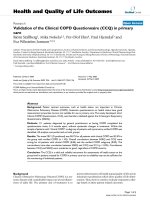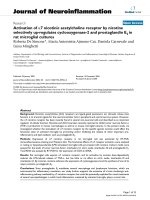Báo cáo hóa học: "Synthesis of Tin Nitride SnxNy Nanowires by Chemical Vapour Deposition" docx
Bạn đang xem bản rút gọn của tài liệu. Xem và tải ngay bản đầy đủ của tài liệu tại đây (491.59 KB, 7 trang )
NANO EXPRESS
Synthesis of Tin Nitride Sn
x
N
y
Nanowires by Chemical Vapour
Deposition
Matthew Zervos Æ Andreas Othonos
Received: 5 March 2009 / Accepted: 26 May 2009 / Published online: 20 June 2009
Ó to the authors 2009
Abstract Tin nitride (Sn
x
N
y
) nanowires have been grown
for the first time by chemical vapour deposition on n-type
Si(111) and in particular by nitridation of Sn containing
NH
4
Cl at 450 °C under a steady flow of NH
3
. The Sn
x
N
y
nanowires have an average diameter of 200 nm and lengths
C5 lm and were grown on Si(111) coated with a few nm’s of
Au. Nitridation of Sn alone, under a flow of NH
3
is not
effective and leads to the deposition of Sn droplets on the Au/
Si(111) surface which impedes one-dimensional growth
over a wide temperature range i.e. 300–800 °C. This was
overcome by the addition of ammonium chloride (NH
4
Cl)
which undergoes sublimation at 338 °C thereby releasing
NH
3
and HCl which act as dispersants thereby enhancing the
vapour pressure of Sn and the one-dimensional growth of
Sn
x
N
y
nanowires. In addition to the action of dispersion, Sn
reacts with HCl giving SnCl
2
which in turn reacts with NH
3
leading to the formation of Sn
x
N
y
NWs. A first estimate of the
band-gap of the Sn
x
N
y
nanowires grown on Si(111) was
obtained from optical reflection measurements and found to
be &2.6 eV. Finally, intricate assemblies of nanowires were
also obtained at lower growth temperatures.
Keywords Tin nitride Á Nanowires Á Synthesis Á
Chemical vapor deposition
Introduction
Nitrides and in particular, group III-Nitride (III-N) com-
pound semiconductors such as GaN, InN and AlN have
been investigated intensively over the past decade due to
their applications in electronic and optoelectronic devices
like field effect transistors, light emitting diodes and lasers
[1–3]. III-N semiconductors are especially attractive
because their band-gap can be tailored from 0.7 eV in InN
[4] up to 6.2 eV in AlN [5] but also due to the strained
induced charges that provide an extra degree of freedom
which can be used to tailor the band-profile and conse-
quently the properties of devices [6].
However, in contrast to III-N compound semiconductors
there are few investigations on group IV-Nitride (IV-N)
compounds such as Ge
3
N
4
[7, 8] and even less on Sn
3
N
4
[9–22].
Tin nitride Sn
3
N
4
is a relatively unknown semiconductor
and the first investigation of Sn
3
N
4
was carried out by F.
Fisher et al. [9] as early as 1908. It has an energy band-gap
that was estimated to be &1.5 eV [11] and so far Sn
3
N
4
thin films have been grown by a variety of methods [12–
19], including, atmospheric pressure chemical vapour
deposition (APCVD) using halides [12, 13], metal organic
chemical vapour deposition (MOCVD) [14], sputtering
[15–18] and ammonothermal synthesis [19, 20]. Thin films
of Sn
3
N
4
have also been proposed as materials for optical
storage [21, 22] since it was demonstrated that it dissoci-
ates into b-Sn upon exposure to a focused beam of light but
also as a material for batteries [23].
Not surprisingly there are very few investigations on
Sn
3
N
4
nanostructured materials and it appears that the only
study carried out so far concerns the synthesis of Sn
3
N
4
nanoparticles (NPs) on Au coated Si(001) via chemical
vapour deposition (CVD) using SnCl
4
Á 5H
2
O as a solid
M. Zervos (&)
Nanostructured Materials and Devices Laboratory,
Department of Mechanical and Manufacturing Engineering,
Materials Science Group, University of Cyprus,
P.O. Box 20537, 1678 Nicosia, Cyprus
e-mail:
A. Othonos
Department of Physics, Research Centre of Ultrafast Science,
University of Cyprus, P.O. Box 20537, 1678 Nicosia, Cyprus
123
Nanoscale Res Lett (2009) 4:1103–1109
DOI 10.1007/s11671-009-9364-0
precursor, by Nand et al. [24]. To date, there is no report on
the synthesis of Sn
x
N
y
nanowires (NWs) despite the fact
that nanowires constitute a fundamental building block for
the development of nanoscale devices such as third gen-
eration solar cells which require low cost, nanostructured
materials.
Therefore in order to complement our earlier investi-
gations on the synthesis and properties of InN NWs and
related oxides such as In
2
O
3
and SnO
2
NWs [25–27], a
preliminary investigation on the growth of Sn
x
N
y
NWs was
undertaken.
Here the synthesis of the first Sn
x
N
y
NWs on Au/Si(111)
is described and it is shown that Sn
x
N
y
nanowires (NWs)
can not be grown via the direct nitridation of Sn over a
broad range of temperatures i.e. between 300–800 °C due
to the formation of Sn droplets on the surface of the
Si(111). While there is evidence of one dimensional (1D)
growth occurring at 500 °C via the direct nitridation of Sn,
the yield is extremely poor. One-dimensional growth was
promoted and significantly enhanced via the incorporation
of NH
4
Cl in the Sn and its sublimation which acts as a
dispersant thereby enhancing the vapour pressure of Sn.
Sn
x
N
y
NWs with an average diameter of 200 nm were
obtained at 450 °C while intricate assemblies of NWs have
also been obtained at lower temperatures.
Experimental Procedure
The Sn
x
N
y
NWs were grown using an APCVD reactor
which consists of four mass flow controllers (MFC’s) and a
horizontal quartz tube furnace, capable of reaching a
maximum temperature of 1,100 ° C. Initially, fine Sn
powder (Aldrich, \ 150 lm, 99.5%) was loaded into a
quartz boat together with a square piece of Si(111)
approximately 7 mm 9 7 mm in size, which was coated
with a few nm’s of Au. The Au layer was deposited via
sputtering at a slow rate using an Ar plasma under a
pressure \10
-4
mBar. The Au/Si(111) sample was posi-
tioned & 5 mm downstream from the Sn and subsequently
the boat was loaded into the APCVD reactor and posi-
tioned directly above the thermocouple used to measure the
heater temperature at the centre of the quartz tube. After
loading the boat at room temperature (RT), Ar (99.999%)
was introduced at a flow rate of 500 standard cubic centi-
metres per minute (sccm) for 5 min in order to purge the
tube and eliminate O
2
and H
2
O. Following this the tem-
perature was ramped to the desired growth temperature in a
NH
3
flow of 250 sccm at a rate of 30 °C/min. Upon
reaching the growth temperature (T
G
) the flow of NH
3
was
maintained at 250 sccm for a further 60 min after which the
tube was allowed to cool down over at least an hour, in a
flow of 50 sccm NH
3
. The sample was removed only when
the temperature was lower than 100 °C.
In order to enhance the one dimensional growth of
Sn
x
N
y
NWs an equal amount of anhydrous NH
4
Cl (VWR
Int 99.9%) was added to the Sn and mixed thoroughly in
the boat. Then the same gas flows and temperature-time
profile described above was employed. A summary of the
temperatures and conditions is given in Table 1. The
morphology of the Sn
x
N
y
NWs was examined with a
TESCAN scanning electron microscope (SEM) while the
crystal structure and the phase purity of the Sn
x
N
y
NWs
were investigated using a SHIMADZU, XRD-6000, X-ray
diffractometer with a Cu Ka source while a scan of h–2h in
the range between 10° and 80° was performed. Finally
optical spectroscopy was carried out using a standard
spectrophotometer UV/V (Perkin–Elmer Lambda 950) in
the reflection mode at near normal incidence to the surface
of the sample.
Results and Discussion
As stated above the only investigation on the synthesis of
nanostructured Sn
3
N
4
is that of single phase, cubic tin
nitride nanoparticles grown via atmospheric pressure-
halide vapour phase epitaxy by Nand et al. [24]. In par-
ticular Nand et al. employed SnCl
4
Á 5H
2
O as a source of
Sn and used 10 nm Au/Si(001) p-type substrates that were
positioned at different distances from the SnCl
4
Á 5H
2
O,
along the reactor. The SnCl
4
Á 5H
2
O was heated up to
500 ° C under a flow of NH
3
and N
2
and the temperatures of
the samples along the reactor were 400, 300 and 150 °C,
respectively. However, Nand et al. [21] did not obtain any
NWs. Before discussing the synthesis of the Sn
x
N
y
NWs
obtained here it is instructive to consider first the synthesis
Table 1 Maximum diameter (Ø) of Sn droplets (DPs) and Sn
x
N
y
NWs obtained from heating up Sn under NH
3
and from the reaction of
Sn ? NH
4
Cl respectively, at different temperatures. In all cases a
ramp rate of 30 °C/min was used to reach T
G
under 250 sccm’s of
NH
3
which was then maintained for a further 60 min at the growth
temperature and after which the reactor was allowed to cool down to
RT in a reduced flow of 50 sccm’s NH
3
T
G
( °C) Max Ø of Sn
DPs (Sn:NH
3
)
Max Ø Sn
x
N
y
NWs
(Sn ? NH
4
Cl:NH
3
)
300 No DPs No NWs
400 200 nm 200 nm
450 – 200 nm
500 500 nm No NWs
600 500 nm No NWs
700 2.0 lm–
800 5.0 lm–
1104 Nanoscale Res Lett (2009) 4:1103–1109
123
of SnO
2
NWs on 0.5 nm Au/Si(111) that were previously
obtained by heating up Sn in an inert gas flow of 100 sccm
Ar at 30 °C/min up to 800 °C and then maintaining the
flow of Ar at this temperature for a further 90 min before
cool down [27]. A typical SEM image of the SnO
2
NWs
obtained in this way is shown in Fig. 1a from which it is
clear that a large yield of SnO
2
NWs was obtained with an
average diameter of 50 nm due to the reaction of Sn with
residual O
2
in the APCVD reactor. Performing the reaction
under a direct flow of O
2
leads to the formation of SnO
2
around the molten Sn which limits the vapour pressure
significantly and hence the growth of NWs. As a conse-
quence the molten Sn upstream always had a grey like, non
reflective appearance at the end of the process, while no
droplets were observed among the SnO
2
NWs. A similar
process was also used recently for the growth of In
2
O
3
NWs at 700 °C[26].
At first sight it would seem that the synthesis of Sn
x
N
y
NWs by direct nitridation of Sn with NH
3
is feasible by
changing from Ar to NH
3
since Sn, like In, has a low
melting point [28] and InN NWs have been obtained by
direct nitridation of In with NH
3
at a heater temperature of
600 ° C[25]. However, Sn
x
N
y
NWs were not obtained by
the direct nitridation of Sn with NH
3
. Instead many Sn
droplets appeared on the Si(111) surface and a typical SEM
image of such Sn droplets after the attempted nitridation of
Sn with NH
3
at 800 °C is shown in Fig. 1b. The Sn
droplets cover the entire surface and have a density
of &10
7
cm
-2
and diameters B5 lm. Furthermore the
size of the Sn droplets decreased as the temperature was
reduced to 600 °C and many of then became elongated as
shown in Fig. 1c.
The formation of large droplets on the Au/Si(111) sur-
face during the direct nitridation of Sn with NH
3
is a direct
consequence of the reducing action of NH
3
which elimi-
nates the background O
2
in the APCVD reactor. This in
turn prevents the formation of an oxide around the Sn and
so the molten drop always had a highly reflective, metallic
like surface. In contrast when Sn is heated up in a flow of
pure, inert Ar, the surface is grey like and not reflective due
to the O
2
background which is responsible for the forma-
tion of SnO
2
NWs that were grown optimally on 0.5 nm
Au/Si(111) at 800 °C using the same temperature-time
profile and Ar as opposed to NH
3
[27].
Apart from droplets, no nanostructures were obtained
via the attempted nitridation of Sn with NH
3
in the tem-
perature range 600 ° C \ T
G
\ 800 °C. Turning on the
flow of NH
3
, after ramping up the temperature in an inert
gas flow of Ar, did not lead to the growth of Sn
x
N
y
NWs
either but again resulted into the deposition of Sn droplets.
However, there was some evidence of one-dimensional
growth at T
G
= 500 °C. Literally a few NWs with diam-
eters [500 nm’s and lengths up to 3 lm appeared at a few
locations on the Si(111) surface, hence the yield was
extremely poor. Nevertheless, a further reduction of the
growth temperature down to 300 °C did not lead to any
Fig. 1 SEM images of a SnO
2
NWs with an average diameter of
50 nm grown on Au/Si(111) at 800 °C in an inert gas flow of 100
sccm Ar. No droplets exist among the NWs b Sn droplets on Au/
Si(111) deposited using the same temperature-time profile in a but in
a steady gas flow of 250 sccm of NH
3
as opposed to Ar. A broad
distribution in the sizes of the Sn droplets was obtained with
diameters B5 lm c similar to b but smaller Sn droplets with
diameters B0.5 lm were obtained at 500 °C many of which are also
elongated
Nanoscale Res Lett (2009) 4:1103–1109 1105
123
significant deposition on the Si, no NWs were obtained and
moreover, the Sn upstream lost its metallic shine due to the
build up of a black deposit on the molten Sn which limited
the vapour transport. In addition, no differences were
observed upon changing the flow rate of NH
3
during the
growth while keeping everything else equal at all temper-
atures so the direct nitridation of Sn alone under a flow of
NH
3
is not effective and leads to the deposition of Sn
droplets on the Au/Si(111) surface which impedes one-
dimensional growth over a wide temperature range i.e.
300–800 °C as shown below in Table 1.
The XRD spectrum of the Sn droplets deposited at
800 ° C is shown in Fig. 3 and is characterized by an
intense peak corresponding to the (2 0 0) orientation of Sn
and less intense but well resolved peaks corresponding to
the (1 0 1), (3 0 1), (4 0 0) and (3 2 1) orientations. In
addition to the Sn droplets the Al holder peaks have also
been identified but no peaks associated with Sn
x
N
y
were
found.
These findings are in direct contrast with the case of
InN where NWs can be grown by direct nitridation of In with
NH
3
via a self-catalytic mechanism. The optimum heater
temperature for the growth of InN NWs was found to be
600 ° C where its vapour pressure is equal to 10
-6
Torr.
Large In droplets comparable in size to those in Fig 1b
started appearing only at temperatures C800 °C in contrast
to the Sn droplets whose density was large and persisted even
down to 600 °C where its vapour pressure is \10
-11
Torr. It
appears therefore that the Sn droplets are born out from the
melt upstream and are transferred to the Si(111) surface
where they coalesce to form larger droplets.
The tendency for one-dimensional growth observed at
T
G
= 500 °C during the direct nitridation of Sn with NH
3
was promoted by the addition of NH
4
Cl into the Sn at a ratio
of 1:1 by weight. The reaction of NH
4
Cl with Sn was carried
out under a flow of NH
3
keeping the flow rate, ramp rate and
temperature profile identical to those used in the case of
‘direct nitridation’ of Sn with NH
3
. A typical SEM image of
Sn
x
N
y
NWs obtained by the reaction of Sn with NH
4
Cl under
NH
3
at 450 °C is shown in Fig 2a. The Sn
x
N
y
NWs have an
average diameter of 200 nm’s and lengths up to 5 lm while
the reaction of Sn with NH
4
Cl always lead to the deposition
of a white powder downstream, near the cool end of the
reactor, in contrast to the direct nitridation of Sn with NH
3
where no by products occurred.
The XRD spectrum of the Sn
x
N
y
NWs grown at 450 °C
is shown in Fig. 4 and is characterized by the (2 2 0), (3 1
1), (5 1 1) and (4 4 0) peaks, which can be indexed to the
hexagonal structure of Sn
3
N
4
[18]. The intense peak of
Sn(200) observed in Fig. 3 has disappeared and once more
the Al peaks appearing in the XRD spectrum of Fig. 4 due
to the sample holder have been identified. Furthermore
there are no peaks associated with SnO
2
[27].
The promotion of one dimensional growth is attributed
to the dissociation of NH
4
Cl. Upon increasing the tem-
perature NH
4
Cl undergoes sublimation at 338 °C and
Fig. 2 a Sn
x
N
y
NWs grown on Au/Si(111) at the optimum temper-
ature of 450 °C using a Sn:NH
4
Cl mixture under a flow of 250 sccm’s
NH
3
b high magnification SEM image of Sn
x
N
y
NWs
10 20 30 40 50 60 70 80
0
100
200
300
28.5
o
Si(111)
Intensity (cps)
2θ/θ (deg)
Sn(321)
Al
Sn(400)
55.5
O
Sn (301)
32
O
Sn (101)
Al
Al
30.8
O
Sn (200)
Fig. 3 XRD spectrum of Sn droplets deposited on Si(111) at 800 °C
under a flow of 250 sccm NH
3
1106 Nanoscale Res Lett (2009) 4:1103–1109
123
therefore dissociates into NH
3
and HCl according to the
following reaction.
NH
4
Cl
ðSÞ
! NH
3
þ HCl ð1Þ
As explained by Chaiken et al. [29] the sublimation rate
of NH
4
Cl increases by a factor of 10
4
when changing the
temperature from T = 100 to 600 °C and the typical
sublimation weight loss of NH
4
Cl is over 90% when heated
for &60 min. It is interesting to point out here that this
sublimation process is endothermic and the temperature is
expected to be reduced only by a few tens °C in the case of
NH
4
Cl [29]. The decomposition of NH
4
Cl enhances the
porosity of the Sn melt and more importantly acts as a
dispersant increasing the amount of Sn that is transferred
into the gas stream. In fact the sublimation of NH
4
Cl and
the generation of NH
3
and HCl gasses which act to disperse
the molten Sn occurs abruptly and leads to strong
dispersion of the molten Sn inside the boat for the ramp
rate used here i.e. 30 °C/min suggesting that lower ramp
rates would be more suitable. In addition to acting as a
dispersant, the sublimation of NH
4
Cl yields HCl which
reacts with Sn leading to the formation of SnCl
2
according
to the reaction,
Sn þ2HCl ! SnCl
2
þ H
2
ð2Þ
Note that SnCl
2
melts at 38 °C and decomposes above
600 °C. Subsequently the SnCl
2
reacts with NH
3
according to,
3SnCl
2
þ 4NH
3
! Sn
3
N
4
þ 6HCl þ 6H
2
ð3Þ
Consequently the role of the NH
4
Cl is two fold. First, it
prevents the Sn from melting up into one single drop and
second it supplies the necessary HCl for the formation of
SnCl
2
. As stated above heating up Sn alone in NH
3
did not
lead to the deposition of any products near the cool end of the
reactor so the deposition that occurs from heating up Sn and
NH
4
Cl in NH
3
is due to the reaction of Sn with HCl since
XRD of the deposit showed no peaks related to NH
4
Cl.
The reaction outlined above is in a way similar to that
put forward by Nand et al. [21] whereby SnCl
4
reacts with
NH
3
according to,
3SnCl
4
þ 4NH
3
! Sn
3
N
4
þ 12HCl ð4Þ
leading to the growth of Sn
3
N
4
NPs on 10 nmAu/Si(111) that
were placed at various positions along the reactor but also
similar to the growth of Sn
3
N
4
thin films by APCVD using
halides, by Gordon et al. and Takahashi et al. [12, 13].
A similar kind of reaction was also used to grow InN
nanocrystals on Si(111) whereby the incorporation of NH
4
Cl
into the In lead to the complete elimination and transfer of the
In into the gas stream where it formed primarily InCl which
in turn reacted with the NH
3
leading to the formation of InN
nanocrystals with diameters of 300 nm [30].
While the addition of NH
4
Cl in Sn did not result into its
complete transfer in the gas stream like with In, it provided
nonetheless the necessary HCl for the formation of SnCl
2
which subsequently reacts with NH
3
on the Au/Si(111)
leading to the one dimensional growth of Sn
x
N
y
. Interest-
ingly the distance of the sample from the Sn:NH
4
Cl mixture
was found to be critical and for distances [10 mm the
reaction led to the formation of closely packed NPs with
sizes \100 nm on the Au/Si(111) most probably due to the
lower vapour pressure of the SnCl
2
.
Although the details of the growth mechanism are not
understood thoroughly at present it is suggested that the
Sn
x
N
y
NWs grow self catalytically from Sn
x
N
y
NPs although
the role of the Au which appears to enhance the one
dimensional growth still needs to be clarified [32, 33].
A first estimate of the band-gap of the Sn
x
N
y
nanowires
grown on Si(111) was obtained from optical reflection
measurements using a UV–IR spectrometer at near normal
incidence on both the NW sample and the Si(111) substrate
for comparison, shown in Fig. 5. Clearly evident is the
distinct difference in the reflection spectra from the
substrate and the NWs. Also evident is the band edge of
the Sn
x
N
y
NWs which is estimated to be approximately
2.6 eV [31].
In addition to Sn
x
N
y
NWs that were obtained at
T
G
= 450 °C there is also evidence for the formation of
more complex nanostructures obtained for T
G
\ 450 °Cas
shown in Fig. 6a and b. However, their density was smaller
compared to that in Fig. 2a due to the lower growth tem-
perature which limits the amount of Sn transferred over to
the Si(111). The radial growth of NWs from the droplet
shown in Fig 6a is very similar to the case of InN [25]
whereby nucleation centres form on the surface of droplets
which then facilitate radial growth [32]. Moreover,
the circular arrangement of NWs shown in Fig. 6b is due to
10 20 30 40 50 60 70 80
0
50
100
150
2θ/θ (deg)
Intensity (cps)
57.7
O
Sn
x
N
y
(440)
Al
Al
52.6
O
Sn
x
N
y
(111)
32.88
O
Sn
x
N
y
(101)
27.8
O
Sn
x
N
y
(100)
Al
Sn (400)
Fig. 4 XRD spectrum of Sn
x
N
y
NWs grown on Au/Si(111) at 450 °C
via the reaction of Sn and NH
4
Cl
Nanoscale Res Lett (2009) 4:1103–1109 1107
123
the formation of droplets that accumulate near the
periphery of well defined circles similar to the growth of
In
2
O
3
nano pyramids that self assemble in the form of
wreaths due to the reaction of In with NH
4
Cl in a flow of
N
2
[30].
Conclusions
The first tin nitride, Sn
x
N
y
nanowires have been grown by
CVD on Au coated Si(111) via the reaction of Sn with
NH
4
Cl at 450 °C under a steady flow of NH
3
. Attempting
direct nitridation of Sn with NH
3
leads to the formation of
Sn droplets due to the reducing action of the NH
3
which
eliminates O
2
in the reactor and which in turn inhibits one-
dimensional growth over a wide temperature range
between 300–800 °C. The formation of large Sn droplets
was suppressed by adding NH
4
Cl which dissociates into
NH
3
and HCl by sublimation at 338 °C and acts as a dis-
persant thereby enhancing the vapour pressure of Sn.
Furthermore the Sn reacts with HCl and yields SnCl
2
which
subsequently reacts with NH
3
leading to the formation of
Sn
x
N
y
nanowires which have diameters of 200 nm and
lengths up to 5 lm. Finally nanowires protruding from
droplets and intricate assemblies of NWs arranged in the
shape of wreaths were also obtained at tempera-
tures \450 °C. The synthesis of metal (M)-nitride i.e.
M
x
N
y
nanowires where the metal component is readily
available and has a low cost, is expected to be important for
third generation solar cells based on nanostructured semi-
conductor materials.
Acknowledgments The work in this article was supported by the
Research Promotion Foundation of Cyprus (www.research.org.cy)
under grant BE0308/03 for fundamental research in the area of
nanotechnology and nanomaterials.
References
1. S. Seo, G.Y. Zhao, D. Pavlidis, Electron. Lett. 44, 244 (2008)
2. Y. Taniyasu, M. Kasu, T. Makimoto, Nature 441, 325 (2006)
3. S. Nakamura, T. Mukai, M. Sengh, Appl. Phys. Lett. 64, 1687
(1994)
4. J. Wu, W. Walukiewicz, K.M. Yu, J.W. Ager, E.E. Haller, H. Lu,
W.J. Schaff, Y. Saito, Y. Nanishi, Appl. Phys. Lett. 80, 3967
(2002)
5. J. Li, K.B. Nam, M.L. Nakarmi, J.Y. Lin, H.X. Jiang, P. Carrier,
Su Huai. Wei, Appl. Phys. Lett. 83, 5163 (2003)
6. M. Zervos, A. Kostopoulos, G. Constantinidis, M. Kayambaki, A.
Georgakilas, J. Appl. Phys. 91, 4387 (2001)
7. M. Yang, S.J. Wang, Y.P. Feng, G.W. Peng, Y.Y. Sun, J. Appl.
Phys. 102, 013507 (2007)
8. T. Maeda, T. Yasuda, M. Nishizawa, N. Miyata, Y. Morita, S.
Takagi, J. Appl. Phys. 100, 014101 (2006)
9. F. Fisher, G. Iliovichi, Ber., Deut. Chem. Ges. 41, 3802 (1908)
10. F. Fisher, G. Iliovichi, Ber., Deut. Chem. Ges. 42, 527 (1909)
Fig. 6 Nanostructures obtained at T = 400 °C on 0.7 nm Au/Si(111)
a NWs emanating from a droplet and b NWs which have grown from
droplets in a circular configuration
Fig. 5 Optical reflection from the Sn
x
N
y
NWs (Left) and plain n-type
Si(111) substrate (Right)
1108 Nanoscale Res Lett (2009) 4:1103–1109
123
11. T. Lindgren, M. Larsson, S E. Lindquist, Proc. 14th Int. Work-
shop on Quantum Solar Energy Conversion, 2002
12. R.G. Gordon, D.M. Hoffman, U. Riaz, Chem. Mater. 4, 4 (1992)
13. N. Takahashi, K. Terada, T. Nakamura, J. Mat. Sci. Lett. 20, 227
(2001)
14. D.M. Hoffman, S.P. Rangarajan, S.D. Athavale, D.J. Economou,
J R. Liu, Z. Zheng, W K. Chu, J. Vac. Sci. Technol. A. 13, 820
(1995)
15. Y. Inoue, M. Nomiya, O. Takai, Vacuum 51, 673 (1998)
16. R. Kamei, T. Migita, T. Tanaka, K. Kawabata, Vacuum 59, 764
(2000)
17. L. Maya, J. Vac. Sci. Technol. A. 11, 604 (1993)
18. R.S. Lima, P.H. Dionisio, W.H. Schreiner, Solid State Commun.
79, 395 (1991)
19. B. Wang, M.J. Callahan, Cryst. Growth Des. 6, 1227 (2006)
20. L. Maya, Inorg. Chem. 31, 1958 (1992)
21. N. Takahashi, M. Takekawa, T. Takahashi, T. Nakamura, M.
Yoshioka, Y. Kawata, Solid State Sci. 5, 587 (2003)
22. T. Maruyama, T. Morishita, Appl. Phys. Lett. 69, 890 (1996)
23. K.S. Park, Y.J. Park, M.K. Kim, J.T. Son, H.G. Kim, S.J. Kim, J.
Pow. Sour. 103, 67 (2001)
24. S.V. Nand, K. Ankur, K. Brijesh, M.B. Raj, Solid State Sci. 10,
569 (2008)
25. A. Othonos, M. Zervos, M. Pervolaraki, Nanoscale Res. Lett. 4,
122–129 (2009)
26. D. Tsokkou, A. Othonos, M. Zervos, Ultrafast time resolved
spectroscopy of In
2
O
3
nanowires, Nanotechnology, (2009) (In
Press)
27. A. Othonos, M. Zervos, D. Tsokkou, Nanoscale Res. Lett. (2009)
DOI 10.1007/s11671-009-9323-9
28. In melts at 156.61 8C while Sn melts at 231.93°C
29. R.F. Chaiken, D.J. Sibbett, J. Sutherland, D.K. Van de Mark, A.
Wheeler, J. Chem. Phys. 37, 2311 (1962)
30. M. Zervos, D. Tsokkou, M. Pervolaraki, A. Othonos, Nanoscale
Res. Lett. (2009). DOI 10.1007/s11671-009-9266-1
31. Vipin. Kumar, Sachin. Kr. Sharma, T.P. Sharma, V. Singh, Opt.
Mater. 12, 115 (1999)
32. Z. Zhang, J. Gao, L.M. Wong, J.G. Tao, L. Liao, Z. Zheng, G.Z.
Xing, H.Y. Peng, T. Yu, Z.X. Shen, C.H.A. Huan, S.J. Wang, T.
Wu, Nanotechnology 20, 135605 (2009)
33. H.J. Fan, A.S. Barnard, M. Zacharias, Appl. Phys. Lett. 90,
143116 (2007)
Nanoscale Res Lett (2009) 4:1103–1109 1109
123









